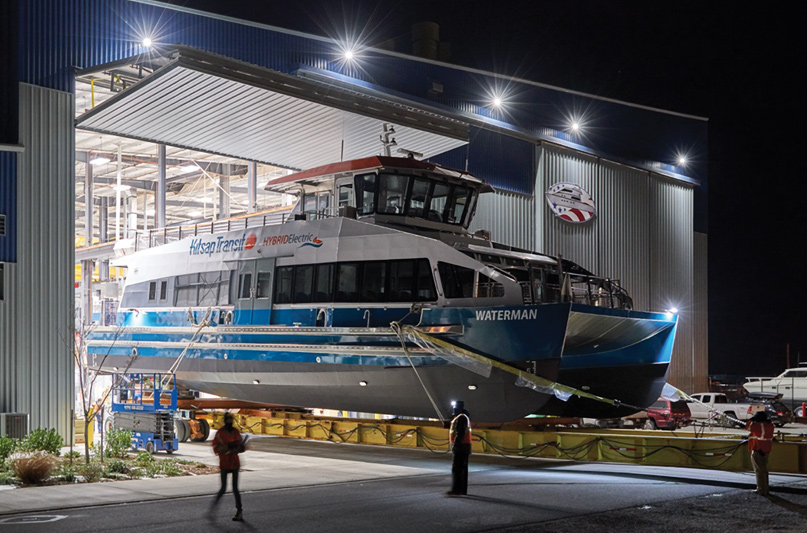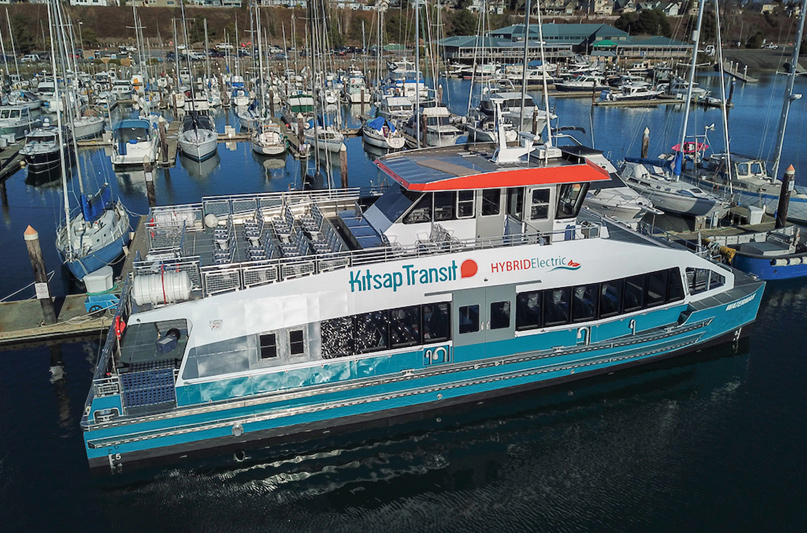 If you ever read a national sailing magazine, you’ll find they regularly feature stories about cruising catamarans, both power and sail, and their popularity for chartering in the Caribbean and the southern states. But you won’t find too many of them in marinas in the Northwest or in the pages of Northwest Yachting—extra-wide moorage space being in short supply here. There’s also not enough hot weather to enjoy much sunbathing on the trampoline or cocktails on the spacious decks. But when it comes to catamaran ferries, Washington’s boat builders lead the nation!
If you ever read a national sailing magazine, you’ll find they regularly feature stories about cruising catamarans, both power and sail, and their popularity for chartering in the Caribbean and the southern states. But you won’t find too many of them in marinas in the Northwest or in the pages of Northwest Yachting—extra-wide moorage space being in short supply here. There’s also not enough hot weather to enjoy much sunbathing on the trampoline or cocktails on the spacious decks. But when it comes to catamaran ferries, Washington’s boat builders lead the nation!
Operators in Hawaii, California, and Alaska rely on our experienced commercial yards to provide them with the latest fast ferry designs from the world’s leading naval architects. During 2018-19, the San Francisco ferry system known as WETA (Water Emergency Transit Agency) is purchasing eight big, aluminum catamarans from 130-150’ long from three Washington yards who all have a relationship with different naval architects in Australia and New Zealand that specialize in catamarans.
This is an important part of our marine economy, which I like to follow as well as I can. But there’s a small problem if you want to keep up with this booming business: as soon as these amazing new boats and their ultra-clean diesel engines have passed their sea trials, they immediately depart for their distant homeports and are never seen again.
That makes it next to impossible for me to see them in operation; and getting a ride is out of the question. My best chance of getting a ride on any of these boats is to go to San Francisco Bay and buy a ticket! If I do, I’ll certainly try to write about it.
Luckily, the latest catamaran delivery on the Salish Sound is the exception to this rule. It was designed and built in Washington for Kitsap County, specifically to run on the short inshore route on Sinclair Inlet between Bremerton, Port Orchard, and Annapolis. (For those of you who aren’t familiar with these waters, this is on the west side of Puget Sound–opposite Seattle.) It is 70′ x 26′, carries 150 passengers, and is powered by the latest hybrid technology, combining a battery bank and a small, clean diesel.
It is appropriately called Waterman—named after the pioneer settler Delos Waterman, and the small community of Waterman (near Bremerton). In the early 1920s, its dock served as a pickup and drop-off point for Mosquito fleet steamers, according to the Kitsap County Historical Society. It was launched at All American Marine in Bellingham on February 5—a sunny day just before the snowstorm hit.
That was just luck of course, but the decision to make this vessel the first hybrid catamaran ferry of its type in the USA was the result of a great deal of discussion and analysis by Kitsap County and Glosten naval architects in Seattle. This will undoubtedly give it a high profile in the international effort to reduce the carbon footprint of ferries along with buses and commuter trains.
Coincidentally, the boat’s propulsion system is descended from a hybrid bus. The BAE HybriDrive propulsion system at the heart of the boat is based on a proven technology used in over 10,000 transit buses operating across the globe. “Toronto recently purchased 255 of our next generation electric drive systems, joining cities such as San Francisco, Boston, London, and Paris,” said a manager for BAE’s Power & Propulsion Systems.

Like the bus, the marine version consists of a diesel generator, propulsion power converter, lithium-ion battery bank, and twin propellers—all controlled by a very smart computer programmed to respond to the changing demands of a specific ferry route. “We are proud to bring this proven technology to the marine sector to reap the benefits of fuel savings and quiet, clean travel,” says BAE.
The Waterman will also operate almost silently while under battery power when maneuvering and docking. “The vessel will operate like a Prius – no more diesel exhaust and noise while passengers load and unload,” said Glosten project manager William Moon. Like a hybrid car, the ferry’s engine will have lower operating hours and the drive line has fewer parts, resulting in savings in fuel and maintenance costs.
Glosten worked closely with Kitsap Transit to create a design suited to Sinclair Inlet, but flexible enough to meet future needs. Passenger comforts were important and include a variety of passenger spaces with lots of natural light, a unique ADA-accessible bow, and a spacious passenger cabin and sun deck.
“We are proud to build advanced hybrid-electric vessels such as the Waterman and work with our visionary partners to develop and construct the boat of the future,” said Matt Mullett, All American’s president and CEO. “All American is at the forefront of the de-carbonization movement in the maritime industry, and the lithium-ion hybrid electric propulsion system on the Waterman is another example of our progress.”
“We are confident that this new addition to our fleet will serve the people of the Puget Sound region for many years to come,” said Kitsap Transit Executive Director John Clauson. This new design is Coast Guard-certified as a “Subchapter T, hybrid-electric passenger vessel,” and is likely to represent the trend toward greater environmental stewardship for short-haul ferries all over the U.S.A.
All American previously built the two 105’ x 33’ diesel-powered catamarans that King County runs between Seattle’s Pier 50 and Alki Point or Vashon Island, and the prototype ultralow-wake 78’ Rich Passage for the Bremerton-Seattle route. Like most of All American’s fleet, they were designed by New Zealander Nick Waal’s Teknicraft design office. They are now building two more Rich Passage-class boats for a regular high-speed service between Bremerton and Seattle.


